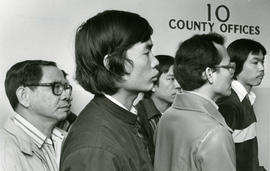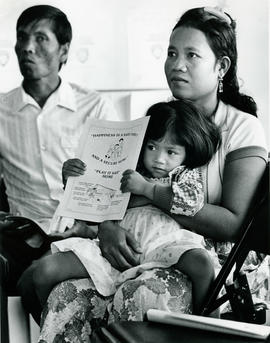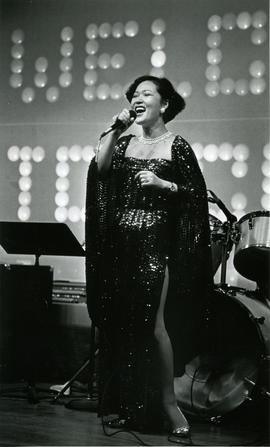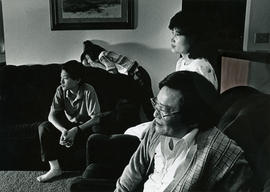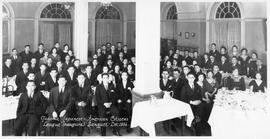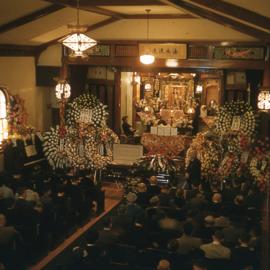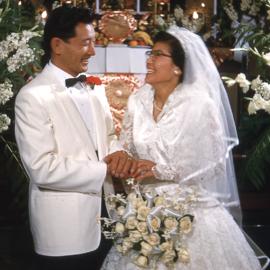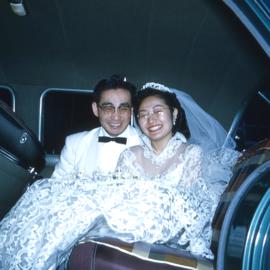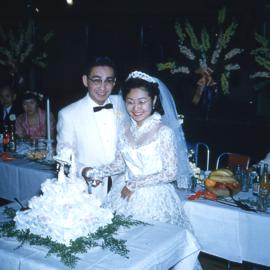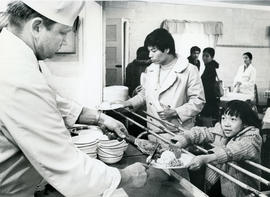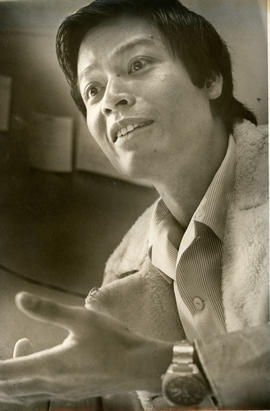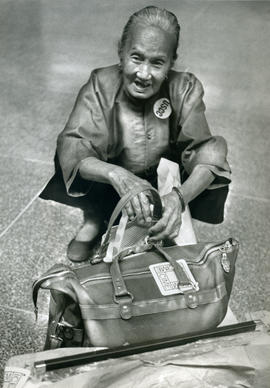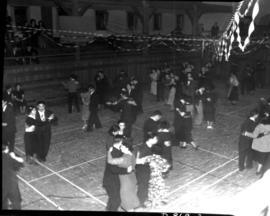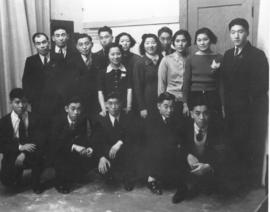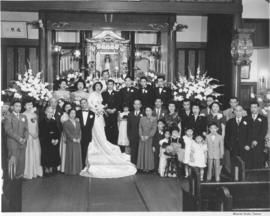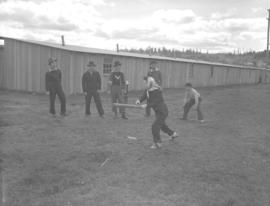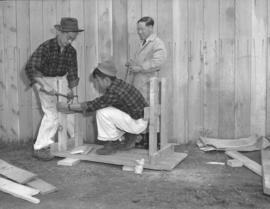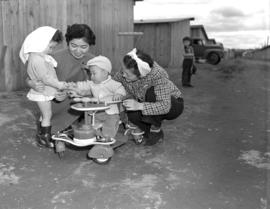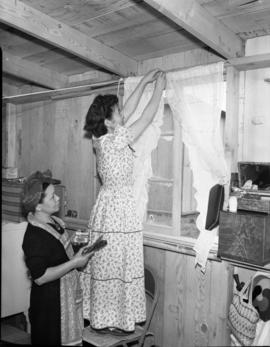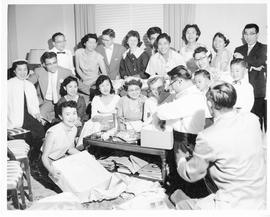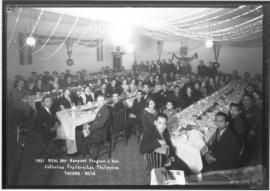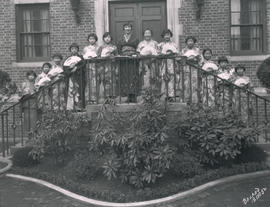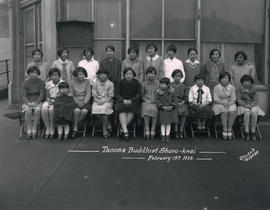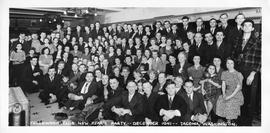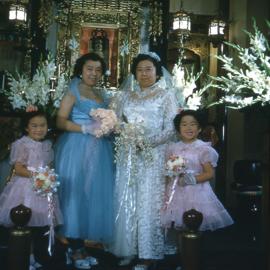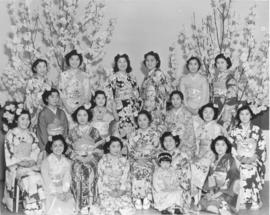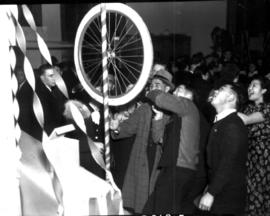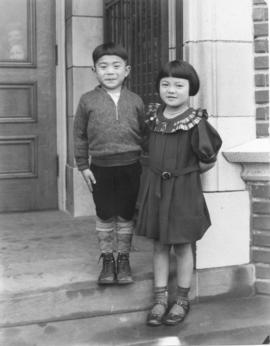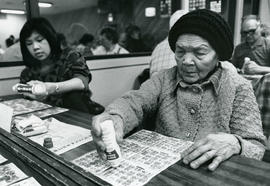- 5.1.2--TNT0055A
- 03/17/1982
Showing 81 results
Collections- 5.1.2--TNT0060A
- 10/07/1987
Back of Photo:
Them Prom Kim holds three-year-old Sokha Buntun during a Tacoma Police Dept. seminar on crime prevention in the Salishan Housing District. These seminars are for people with limited knowledge of English.
Photo by Joe Giron
- 5.1.2-TNT0016K
- 01/21/1988
Back of Photo:
Miss Nan Yung Chung sings Top 40 hits in English and Korean at the Torch Light, a Korean nightclub on South Tacoma Way.
Story by Dorian Smith
Photo by Bill Hunter
- 5.1.2-TNT0017K
- 09/22/1988
Back of Photo:
The Chang family watches some of the Olympics in their Puyallup home. They are from Korea, now American residents (citizens).
L to R: Chase, Carol, Oak (mother) and Soo Nam.
Story by Voelpel
Photo by Peter Haley
- 2.1.1-RSO-10
- Item
- 1934-12-01
Part of Richards Studio Photographs
Panorama of the Japanese-American Citizen's League Inaugural Banquet.
- 2.1.1-RSS-27
- Item
Part of Richards Studio Photographs
Aki Yotsuuye Funeral photograph with large floral arrangements located inside of a Buddhist temple.
- 2.1.1-RSS-61
- Item
Part of Richards Studio Photographs
Saraki-Sagami wedding photo at the altar.
- Item
Part of Richards Studio Photographs
Yasuda-Miyamoto wedding photo of the couple inside of a vehicle with plaid interior seating.
- Item
Part of Richards Studio Photographs
Yasuda-Miyamoto wedding photo of bride and groom cutting the cake with floral arrangements, fruit bowl and 7-Up bottle in the background.
Vietnamese (Refugees, Etc.) - 4
- 5.1.2--TNT0004V
- 06/11/1975
Chef Leonard Travka dishes out food to Vietnamese refugees at Camp Murray.
Vietnamese (Refugees, Etc.) - 5
- 5.1.2--TNT0005V
- 06/16/1975
Back of Photo:
Kiem Van Dao
Photograph by Bob Rudsit
Vietnamese (Refugees, Etc.) - 10
- 5.1.2--TNT0010V
- 07/15/1979
A Vietnamese refugee holds her belongings following an 11-hour flight from Hong Kong
- Item
- 1937-11
Part of Richards Studio Photographs
A large group of young, predominately Japanese, couples dance on the Fife High School gymnasium floor during a Japanese bazaar. (T. Times).
Japanese Americans--Fife--1930-1940; Bazaars--Fife--1930-1940; Dance parties--Fife--1930-1940; Ethnic groups--Fife--1930-1940; Ballroom dancing--Fife--1930-1940;
- Item
- 1937-11
Part of Richards Studio Photographs
A group of the 16 original founding members of the Japanese American Citizen's League pose for their portrait on the stage of the Fife High School gymnasium during a Japanese bazaar held in November of 1937. The Japanese American Citizen's League was founded in 1929. (T. Times).
Japanese Americans--Fife--1930-1940; Bazaars--Fife--1930-1940; Ethnic groups--Fife--1930-1940;
- Item
- 1950-11-12
Part of Richards Studio Photographs
Hashimoto-Fujita wedding. A formal portrait of the bride and groom, their wedding party and four generations of their families. The large group stood in front of a Buddhist altar on November 12, 1950.
Japanese American families--Tacoma; Weddings--Tacoma--1950-1960; Wedding costume--1950-1960; Brides--1950-1960; Grooms (Weddings)--1950-1960; Altars--Tacoma;
- Item
- 1942-05-16
Part of Richards Studio Photographs
The biggest enemy at "Camp Harmony" was boredom. Here a game of sandlot baseball has been organized to give this group some exercise and fresh air. More than 7,000 people of Japanese descent were interned at the camp. Men, women and children were crowded into a small living space. The orderly Japanese soon devised ways to keep their people occupied. Classes were mandatory for children and available for adults. Arts, crafts and recreational activities were devised. Entertainment was brought in; movies were shown. Every effort was made to make life appear ordinary.
Camp Harmony (Puyallup); Relocation camps--Puyallup; World War, 1939-1945--Relocation camps; Japanese Americans--Evacuation & relocation, 1942-1945;
- Item
- 1942-05-16
Part of Richards Studio Photographs
While interred at "Camp Harmony", in May of 1942, three unidentified Japanese Americans built their own furniture for their barracks "apartments." The Puyallup Assembly Center "Camp Harmony" had been constructed by the Army in less than 3 weeks. The living quarters were makeshift barracks divided into "apartments," consisting of a single room no larger than 18 x 20 feet in which a whole family of up to 7 would live. Furnishings consisted of one army cot per person. Each "apartment" had a stove for warmth, one bare bulb hanging from the ceiling by a wire for light and one window. There was no running water. Toilets and showers were communal with no privacy dividers, until the Japanese built them themselves. As Spring passed, the detainees scrounged wood and tools and began constructing rough tables and chairs. Homes were created in the rough surroundings.
Camp Harmony (Puyallup); Relocation camps--Puyallup; World War, 1939-1945--Relocation camps; Japanese Americans--Evacuation & relocation, 1942-1945; Carpentry;
- Item
- 1942-05-16
Part of Richards Studio Photographs
In the spring of 1942, four months after the bombing of Pearl Harbor, more than 100,000 residents of Japanese ancestry were forcibly evicted from their homes in Washington, Oregon, California, Arizona and Alaska and sent to temporary assembly centers, from there to be sent to internment camps in remote inland areas to sit out the war. The Puyallup Assembly Center, hastily erected by the Army in less than 3 weeks and known as "Camp Harmony," was utilized from April 28- September 12, 1942. On May 16, 1942, two year old Beverly Higashida and Lillian Fujihara were getting acquainted with Mrs. M. Kaniko and her seven month old son Wayne. The pictured group was all from Seattle. By the end of May, more than 7,000 people were crowded into the camp. The stoic Japanese made the best of a bad situation, forming their own government, schools and entertainments. The worst aspect of the camp was boredom in the confined quarters. A call went out for recreational materials, such as young Wayne's tricycle. (T. Times 4/30/1942, pg. 9)
Camp Harmony (Puyallup); Relocation camps--Puyallup; World War, 1939-1945--Relocation camps; Japanese Americans--Evacuation & relocation, 1942-1945; Children riding bicycles & tricycles; Fujihara, Lillian; Higashida, Beverly; Kaniko, Wayne;
- Item
- 1942-05-16
Part of Richards Studio Photographs
Mrs. Mito Kashiwagi and her mother-in-law, Mrs. Y. Kashiwagi, decorate a window in the barracks at "Camp Harmony" with sheer curtains in this photograph from May, 1942. In the Spring of 1942, more than 100,000 residents of Japanese ancestry from WA., OR., CA. , AZ. and AK. were forcibly rounded up and sent to internment camps. The hastily erected "Camp Harmony" in Puyallup served as a temporary assembly center, where 7,000 residents from the Seattle and Tacoma area waited while more permanent detention centers were erected. They lived in makeshift barracks, where each family was assigned one room, approximately 18 x 20, with a heating stove, bare light bulb and one window. The barracks had no running water. They shared communal showers, one for each 250 detainees, and toilets. The interns set about making these green wood boxes a home. Wood was scrounged to make furniture, curtains were sewn and hung at the windows, and drawings and pictures from calendars were tacked to the walls. (T. Times 4/30/1942, pg. 9)
Camp Harmony (Puyallup); Relocation camps--Puyallup; World War, 1939-1945--Relocation camps; Japanese Americans--Evacuation & relocation, 1942-1945; Kashiwagi, Mito--Family;
- Item
Part of Richards Studio Photographs
Family gathering before or after the wedding of University of Washington graduates Luana Chizuru Uyeda and Dr. Keith Hiroshi Yoshino.
- Item
- 1931
Part of General Photograph Collection
On December 30, 1931 a banquet was held by the Filipino community of Tacoma to pay homage to Dr. Jose Rizal y Mercado, national patriot, hero and martyr. The members of Catholica Fraternitas Philippina met in the St. Leo's High School social hall at 1323 So. Yakima. The program for the evening included an address of welcome by Mariano Doniego, a steel guitar solo by Jose Pamoso, and a violin performance by Phil A. Corpus. (TNT 12/29/1931)
Ethnic groups--Tacoma--1930-1940; Filipinos--Tacoma--1930-1940; Catholica Fraternitas Philippina (Tacoma);
- Item
- 1928-02-08
Part of Marvin Boland Photographs
Japanese American children from Fife line up on the steps of the First Presbyterian Church on February 8, 1928, dressed in traditional kimonos and with open fans. The tall young lady in the center of the photograph is their teacher, Miss Jones, who wears a kimono with thick obi. The positioning of the young girls on the steps resembles a gently opened fan. That afternoon the First Presbyterian Church sponsored a "Tea of Nations" which attracted 400 guests. Many countries in which the church had missionary programs were featured in a pageant of nations; these young girls may have been invited as representatives of Japan. They would be led in song by Miss Jones. G39.1-188A (Tacoma Sunday Ledger, 2-5-28, D-1-article on Tea of Nations)
Japanese Americans--Tacoma; Children--Clothing & dress--Tacoma--1920-1930; Kimonos; Fans (Accessories);
- Item
- 1928-02-19
Part of Marvin Boland Photographs
Tacoma Buddhist Shoso-kwai. The Shoso-kwai, which may have translated to "youth meeting," poses outdoors, sans coats, on February 19, 1928. The young girls belonged to the Tacoma Buddhist Church which met at the site of the Columbus Hotel on Market St. Two years later in 1930, the church would move to its present location on Fawcett Avenue. G39.1-189; TPL-2840.
Japanese Americans--Tacoma; Clubs--Tacoma--1920-1930;
- 2.1.1-RSO-09
- Item
Part of Richards Studio Photographs
Panorama of the Fellowship Club's New Year's Eve Party.
- 2.1.1-RSS-26
- Item
Part of Richards Studio Photographs
The Yoshihara - Youchura (sp?) Wedding with bride, best maid and two flower girls around ceremonial figures and floral arrangements.
- 2.1.1-RSS-31
- Item
Part of Richards Studio Photographs
Bride and family in formal dress at the Yasuda-Miyamoto wedding with floral arrangements and Buddhist imagery in the background.
- Item
- 1938-11-10
Part of Richards Studio Photographs
Group portrait of eighteen young women, and a child, who are members of the Puyallup Valley Japanese-American Citizens League dance group. They will be performing a ceremonial dance in traditional Japanese dress during "Japan Night," a Japanese bazaar, to be held at Fife High School on November 12, 1938. Over 1,000 people attended the event that offered a glimpse into the island empire's ancient culture. In the afternoon, girls in kimonos served Japanese noodles, rice curry and "osushmis" as well as American salads, pies and hot dogs. In the evening, a program of the dances of old Japan was performed before a background of cherry blossoms and red, white and blue hangings. (T. Times, 11/10/1938, p. 20; 11/14/1938, pg. 3).
Kimonos; Japanese-American Citizen's League (Tacoma); Japanese Americans--Fife--1930-1940; Ceremonial dancers; Japanese Americans--Dance;
- Item
- 1937-11
Part of Richards Studio Photographs
Three Japanese men spin a bicycle wheel at one of the games of chance offered at a Japanese bazaar held in the Fife High School Gymnasium. (T. Times).
Japanese Americans--Fife--1930-1940; Bazaars--Fife--1930-1940; Ethnic groups--Fife--1930-1940; Games--1930-1940;
- Item
- 1934-10
Part of Richards Studio Photographs
In 1934, Hisasha & Ruby Kumasaka received $10,000 each in the will of 80-year-old logger Sweny Smith. Ruby, 7, and Hisasha, 5, were the children of Mr. and Mrs. Tom Kumasaka of 1706 Broadway. For eight years, the family had taken Smith into their home and taken care of him. Despite his Norwegian heritage, Smith observed the Japanese holidays, attended the Buddhist church and followed the family's customs. He spoke of the two children as his grandchildren. On his deathbed in St. Joseph's Hospital, he told the children that he was going to the Great Beyond to watch over them and their growth, and directed them to a safety deposit box in the Washington Building that contained his will leaving everything to them for their kindness. The Kumasaka family, unaware that the frugal logger had any wealth, expected only a meagre amount, but found that the will left $10,000 to each of the children. (T. Times 10/31/1934, pg. 6)
Japanese Americans--Tacoma; Children--Tacoma--1930-1940; Kumasaka, Ruby; Kumasaka, Hisasha;
- 5.1.2-TNT0045B
- 02/27/1987
Back of Photo:
--BJ's Bingo, new Indian gambling rules.
Lazara Gallardo, 90, of Tacoma plays bingo at BJ's Bingo Hall Friday. Her granddaughter, Lamar Abalahin, 22, of Tacoma is sitting behind her. They were playing in hopes of winning one of the six Yugos given away at BJ's. The winner of the car was Lazara's daughter! (Juanita A. Pastor, winner)
Photo by Susie Post
